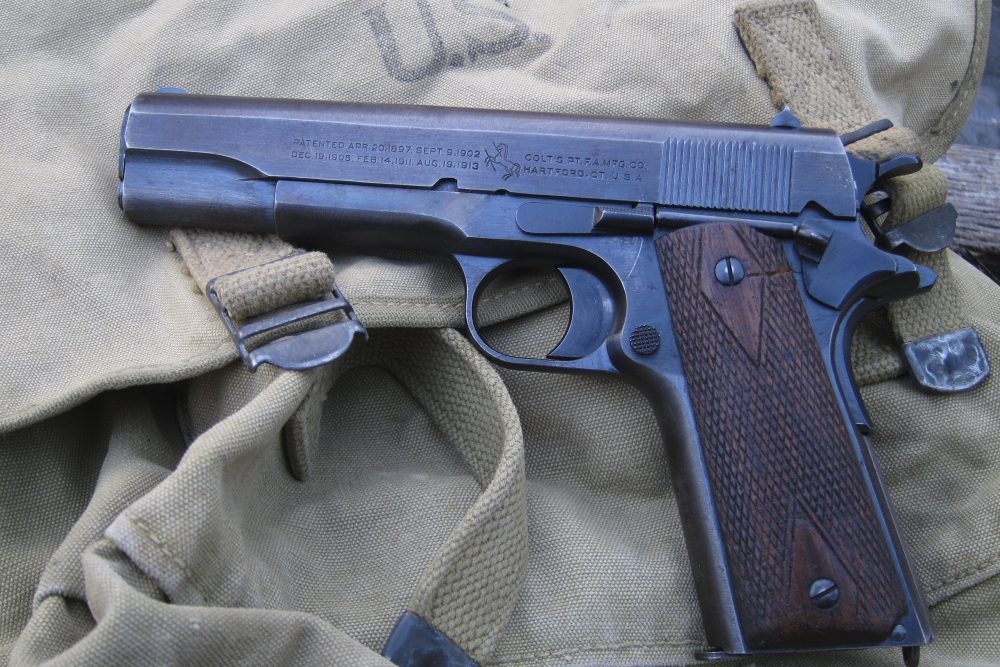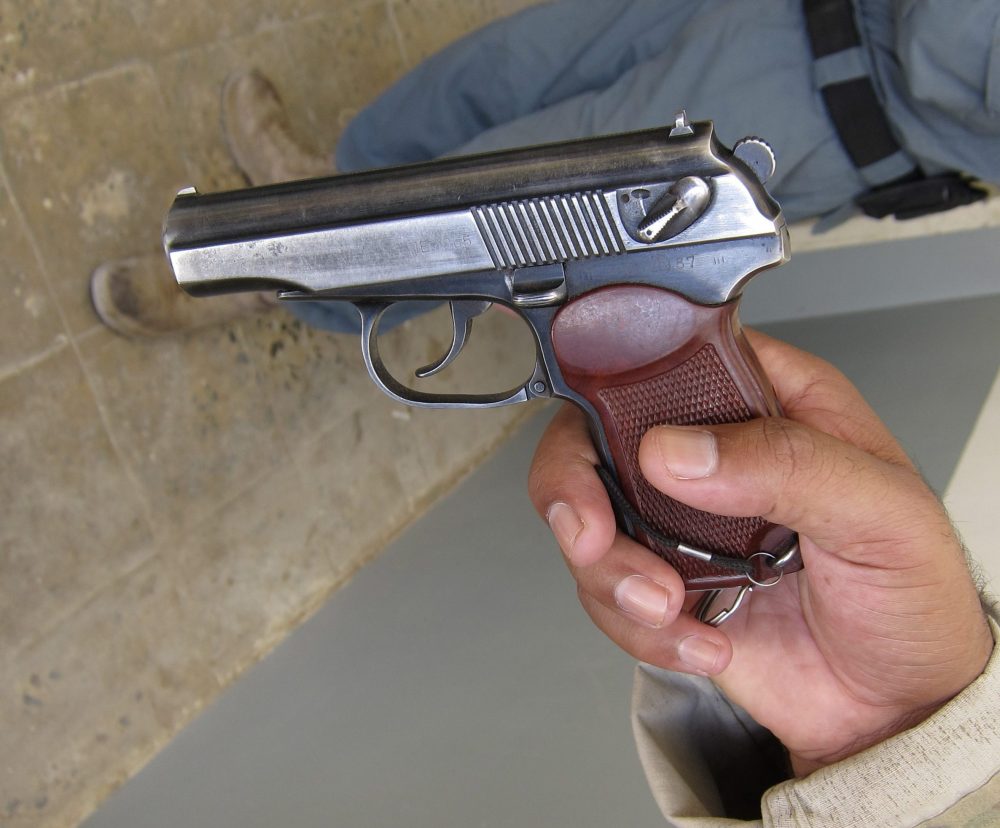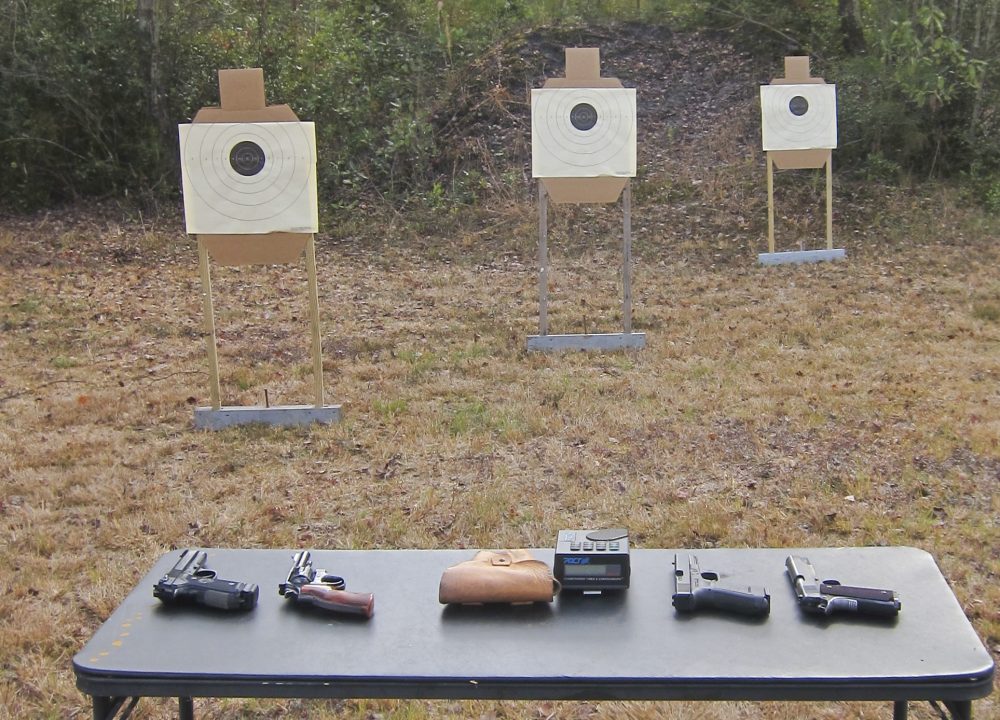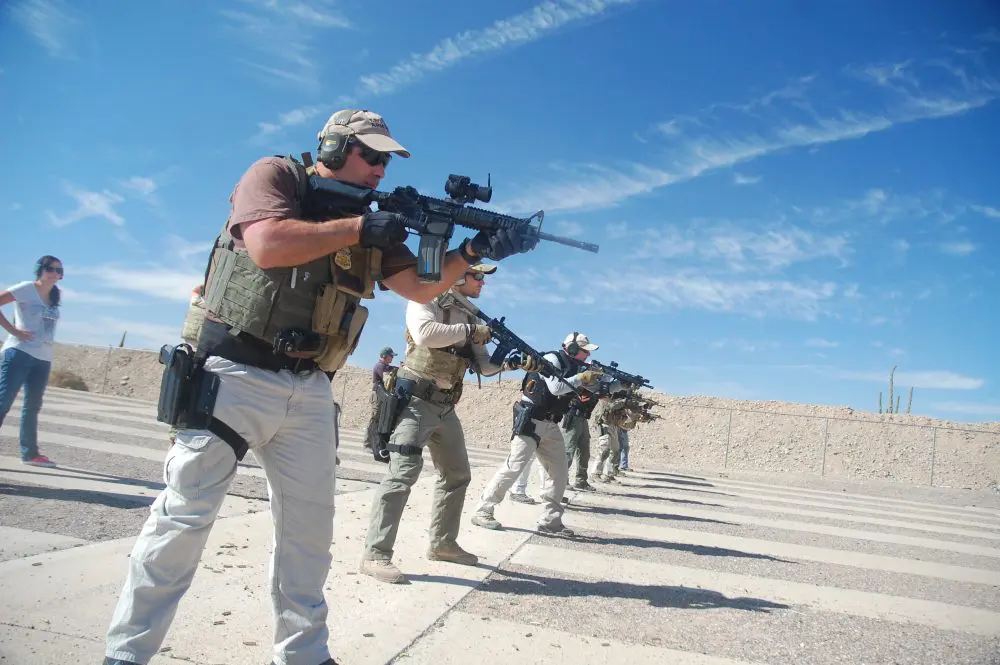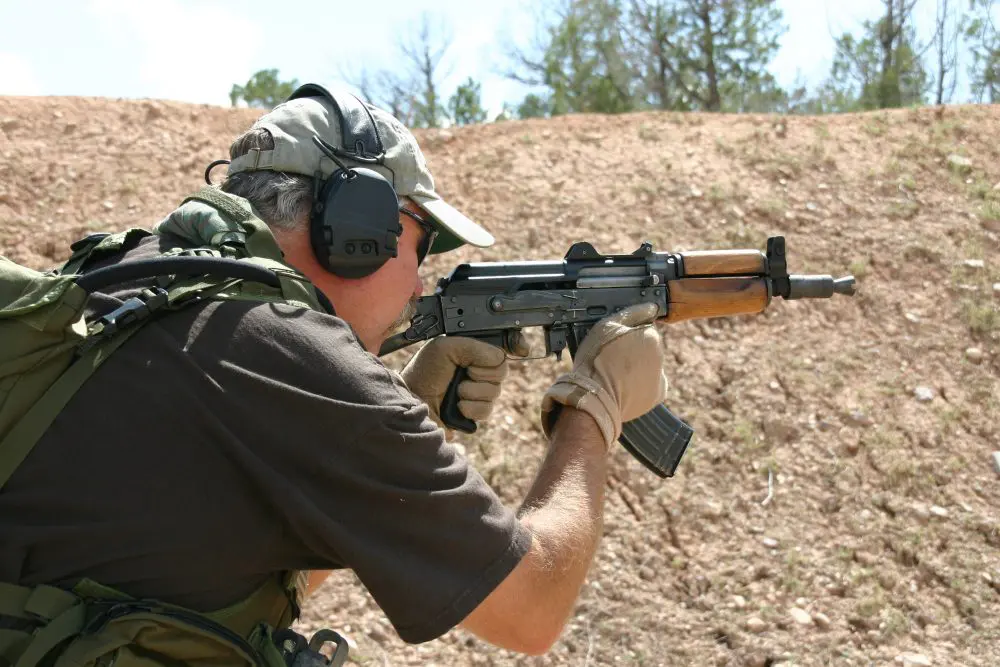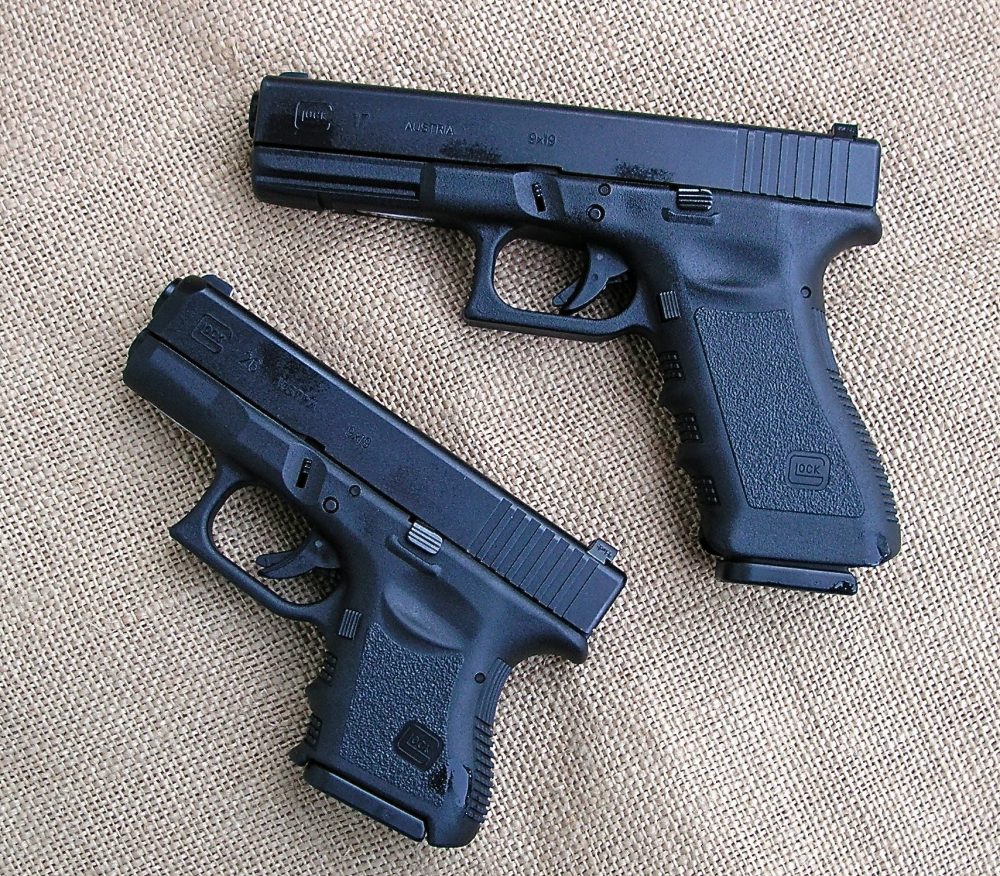Predominant U.S. law enforcement battery consists of the Glock, J frame, and 870 shotgun.
Like most gun guys and red-blooded American fighting men, I can’t help but notice the hardware of the locals and police/security forces when I travel. This is partly because I’m interested, but also because you never know when that type/model/series may be the weapon of opportunity in a crisis.
Depending on one’s personal situation, that could be an active shooter scenario, a battlefield pick-up, or a post natural or man-made disaster acquisition. Whichever it is, being well informed and “spun up” on the system falls in the good-to-know bracket.
A disclaimer is in order here:
In the event that you are thrust into the middle of a domestic terror or deranged gunman scenario, be mindful that if you are standing near a downed individual holding his or her weapon, you stand an even chance of being engaged by both friend and foe despite your best intentions.
Careful consideration and sound decision-making are in order. Solving the immediate problem may be the highest priority, followed closely by situational awareness and proactive communication to those in the area or approaching.
American obsession with 1911 ensures its place on the list, but vast quantities of WWII-era single-action autos across the globe are all functionally similar.
There are several standards in the pick-up game. Stateside it is prudent to know how to run what the local police or sheriffs wear. If there are a standardized or prevalent backup and long gun, those are good to know as well. If you’re reading this magazine, chances are close to 100% that you can rattle off without any strong effort what your gendarmes carry and probably what they carried before that. You can’t help it, I know.
Overseas there are a few givens. One, if the Axis or Allies moved or fought there, examples of those forces’ weapons still exist there. Guaranteed.
Second and more pronounced, in the Third World, the weapons will align with the service arms of their colonial power, Cold War sponsor, or both.
The situation will dictate correct response, but the competing priorities are likely to be getting the weapon into action and running a systems check to verify status. For example, stateside the overwhelming majority of service pistols are carried with a chambered round, whereas in many areas overseas, the norm is a magazine inserted with an empty chamber (aka Condition 3 carry).
Still in wide circulation as a service pistol and carry gun in most communist-influenced areas, Makarov is a must-know for travelers.
In a domestic immediate threat situation, you could play the odds and present and engage with an acquired pistol with reasonable certainty. Across the pond (any of the big ponds), the better immediate-threat action would be to assume an empty chamber and rack the slide on a semi-auto as the weapon is presented.
Given any brief opportunity in either scenario, the priority is to run a systems check: verify the load status, correct that as required, ensure engagement of the magazine latch, verify position and status of the safety, and then remember to grab any spare magazines or ammunition that may be available.
There are a few weapons every able-bodied man should know how to pick up and run. The base list is five pistols and three long guns, with near-infinite variations based on any given individual’s circumstances.
This list is not all-inclusive but a great starting point for basic capability that transfers well to similar systems and is meant to cover stateside life as well as general worldwide hotspots.
In no particular order, here we go:
Beretta 92 series M9 can be found alongside our military and in most places they have been recently. Photo: SGT C. Heff, DOD
Table of Contents
GLOCK
Far and away the most common American police service pistol, the Glock is also in wide service in federal agencies and limited military service. Overseas, it is present just about anywhere you go in at least some numbers. If you haven’t familiarized yourself with operating a Glock, you are behind the shooting curve.
Generation, frame, and caliber aren’t that significant from a familiarization standpoint. If you can operate a first generation 17 (full size 9mm), you can reasonably adapt at first grasp to a subcompact .40 made yesterday.
There are several quirks to keep in mind.
The magazine and slide release are miniscule and prone to fumbling and then failing to release their respective items without pretty deliberate pressure. In haste, there is merit to simply running the slide over the top to recharge the weapon from slide lock. There is wide variation in trigger weights and “feel,” but most have a good bit of take-up and roll to them, so keep the trigger press moving.
Pick-up challenge requires shooter to grab weapons and engage three targets with three rounds each, reloading between targets two and three. Score is shooter’s total time with penalties added.
BERETTA M9
In a stateside crisis or traveling in a war zone, you can reasonably expect to see the venerable and much maligned M9. In a civil disaster, National Guardsmen will be carrying the open-top double/single-action 9mm, should you happen on a situation requiring you to pick up where the Guardsman left off.
Domestically, there are also large numbers of privately owned civilian equivalent 92s thanks to police trade-ins, returning servicemen buying their type of sidearm, and the 1980s buying craze kicked off by the Beretta’s starring role in seminal action movies like Die Hard and Lethal Weapon.
Elsewhere, aside from our troops, the Afghan National Army carry the Beretta, meaning that it is guaranteed to be available on the battlefield as well as the black market.
The M9 is a much better pistol than it is commonly assumed to be. It is arguably the most accurate service pistol ever issued, and extremely reliable if quality magazines are used and the pistol is moderately clean and has even sparse lube on the locking block. The single-action trigger pulls are universally very useable, and the sights are good to go as they are.
For the 1911 crowd, remember that the safety is swept “up” to fire and, if you choose to run the slide over the top, there is a nine-in-ten chance you will re-engage the safety—be wary.
The M9 is one of the few pistols that even novices seem to be comfortable carrying with a round chambered due to the safety and DA trigger.
World hotspots are carpeted in AK variants. Every serious shooter should be able to operate the Kalashnikov.
MAKAROV
For the world traveler, the Mak is a must know. Stateside, not so much, but in most of the crappy areas of the world that people fight in, the Makarov is issued or present in quantity.
The PM remains the service pistol in a variety of former Soviet states or satellites. It is partial issue to the Afghan National Police, and many Afghans choose the 9x18mm as a concealed carry weapon.
It is often surprising to American shooters that so many hard dudes in the world are comfortable relying on .380 level ballistics, but in the developing and remote areas of the globe, availability and durability are driving forces. They seem to be perfectly happy shooting each other with the 9×18—even when options with greater capacity than the Mak’s eight rounds or greater muzzle energy are available.
The Makarov and its ammo are readily available and the pistol is typically Soviet—overbuilt and unlikely to have much breakage. The Makarov safety is down to fire, and the magazine release is on the heel of the grip. In the early 1990s, there was a big wave of imported Maks that saw some limited popularity due to can’t-miss pricing, but they are not especially common in the U.S. today.
The only manually operated long gun on the list, the shotgun is simple but still requires some familiarity for effective employment.
1911
The 1911 is more popular today than ever, and is widely available and used domestically for recreation and home defense, and by a good many CCW users due to its flat profile.
Every American man should know how to run old slabsides for the experience and rite of passage if no other reasons, but the reality is that whether a Browning Hi Power, Soviet TT 33 Tokarev, or some less prolific single-action semi-auto handgun, the manipulation is typically parallel to that of the 1911.
REVOLVERS
The classic Smith & Wesson medium-frame double-action revolver is still present in large numbers with armed security guards and armored car drivers. The small J-framed Smiths are far and away the predominant backup for law enforcement and primary weapon of licensed carry permit holders.
If you can run either size revolver, you should be able to adapt to just about any other DA revolver pretty quickly. Enthusiasts will chafe and point out differences in cylinder rotation and cylinder release latch direction by maker, but the average human is smart enough to overcome these things in the unlikely event he or she runs across a Colt Agent or Ruger Service Six.
With widespread military, LE and sporting use, AR is the most popular American rifle. Photo: DoD
AR
The AR, in addition to being the longest-serving rifle in our military history, is also extremely popular for sporting use and becoming more so each year.
There are increasing numbers of ARs in patrol cars and on special response teams, making it highly probable that the AR will be present at any large event stateside—possibly on both sides.
SHOTGUNS
The shotgun remains in many cruisers and U.S. suburban and rural homes.
It is surrounded by more myth than can be dispelled here, but some caveats worth hitting: Given time, check the load to ensure what you are shooting. In LE configuration, chances are strong it’s buckshot, but it might be non-lethal rounds, which may or may not be better than simply taking cover.
In civilian counterpart, birdshot is commonly used for home defense and may not provide the range or penetration required. Whatever the case, the scattergun spreads in the ballpark of one inch of pattern per yard of distance from the muzzle, so in many cases there is a lot more aiming required than is often assumed.
The shottie is often carried in “cruiser ready” (an empty chamber and full mag tube), and knowing how to release the action to cycle the first round can stump unexpecting shooters.
Getting acquainted with a Remington 870 and a Mossberg 500 will cover the majority of shotguns in the United States.
Venerable medium-frame revolver is still in limited service and widespread distribution. Examples here include well-worn S&W Military & Police that served as a constable’s duty revolver in the deep South, and vintage Model 15.
AK
The AK tends to be wherever there is a fight. It’s a pretty intuitive weapon, designed as it was for conscript armies, and it is a rare clown who can’t figure one out in short order.
One note to consider: in most areas where I’ve seen the AK carried, it has been chamber empty and safety on. The sights are pathetic and under stress it’s easy to pick up the front sight housing wings by mistake due to the rear sight notch being so tiny.
Given that the rifle requires a tool to correct the sights and zero, it’s more common than not to find one that is “kind-of” zeroed, but not to a refined degree.
THE DRILL
I wanted to run a drill that would place each of the big eight across a relevant scenario. Chances are that, with a couple of shooting buddies, you can scrape up the required guns, or use the pick-up challenge as a reason to acquire those missing.
Three B-8 25-yard pistol targets were set up, initially at five, seven, and ten yards. Each weapon was loaded with six rounds, safety on, with a three-shot magazine or reload staged next to it.
In turn, each of the weapons was retrieved on the signal fired, with three shots per target, reloading between targets two and three. Times were recorded and hits scored for each run.
The 1911, AK, and 870 started with an empty chamber to initiate the drill. For the long gun stages, the five-yard target was leapfrogged back to 20 yards to give a longer shot. The shotgun was fired with 00 buck, with the best three pellets on each target counting for score.
The drill is designed to push multiple well-aimed shots to multiple targets in the mode of, “ I just picked this up, things are bad, I’d better get this right.” Target distances were chosen to give near and farther shots without getting to a distance where slight deviations in zero/sight regulation would skew results.
The required actions force the shooter to function all the weapon’s controls under time pressure, with enough accuracy required to ensure focus and application of the sighting system.
Passing is 140 seconds total with a score of 650 or better out of the possible 720, meaning that the drill is designed with the 5.5-inch bull as the no-fault zone, and 10 or X-ring hits compensating for a few loose hits in the outer rings. Every point below 650 adds half a second onto the time. The marker for max credit bragging rights is 100 seconds.
The drill may sound easy, but some shooters find that they are losing a disproportionate amount of time on certain aspects, such as getting the AK and 870 into action, reloading the wheel gun, and/or stuffing shells into the shotgun. This is because these may be unfamiliar actions and, while frustrating, the whole point of the exercise is to force a passing level of familiarity with all eight weapons.
The spread of times across all eight pick-ups makes it important for the shooter to “bring it” in order to max the course, requiring a master-level performance.
Taking on the drill and applying some time behind each of the firearms broken out here is a worthy effort.
Whether for a well-rounded shooter appreciation or in the emergency preparedness sense, the pick-up challenge is good shooting.


